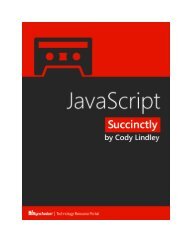JavaScript_Succinctly
Create successful ePaper yourself
Turn your PDF publications into a flip-book with our unique Google optimized e-Paper software.
window). The second way is to use the this keyword in the global scope. Each of these<br />
is detailed in the following sample.<br />
Sample: sample67.html<br />
<br />
var foo = 'bar';<br />
windowRef1 = window;<br />
windowRef2 = this;<br />
console.log(windowRef1, windowRef2); // Logs reference to window object.<br />
console.log(windowRef1.foo, windowRef2.foo); // Logs 'bar', 'bar'.<br />
<br />
In this example, we explicitly store a reference to the head object in two variables that<br />
are then used to gain access to the global foo variable.<br />
The head object is implied and typically not referenced explicitly<br />
Typically a reference to the head object is not used because it is implied. For example,<br />
in the browser environment window.alert and alert() are essentially the same<br />
statement. <strong>JavaScript</strong> fills in the blanks here. Because the window object (i.e. the head<br />
object) is the last object checked in the scope chain for a value, the window object is<br />
essentially always implied. In the next example, we leverage the alert() function<br />
which is contained in the global scope.<br />
Sample: sample68.html<br />
<br />
var foo = { // window is implied here, window.foo<br />
fooMethod: function () {<br />
alert('foo' + 'bar'); // window is implied here, window.alert<br />
window.alert('foo' + 'bar'); // window is explicitly used, with<br />
the same effect.<br />
}<br />
}<br />
foo.fooMethod(); // window is implied here, window.foo.fooMethod()<br />
<br />
81



